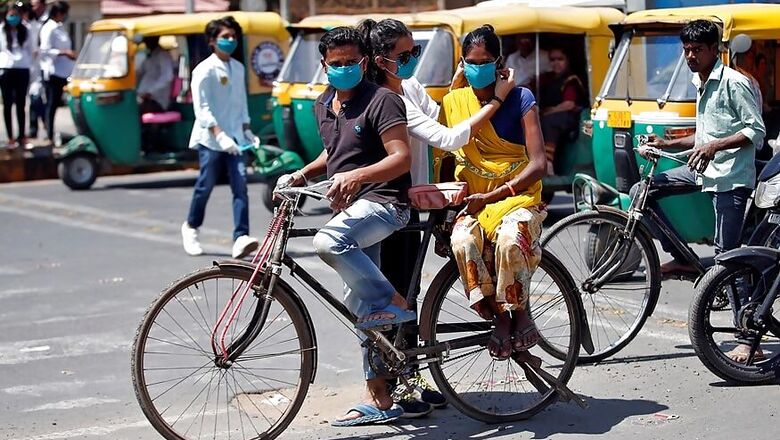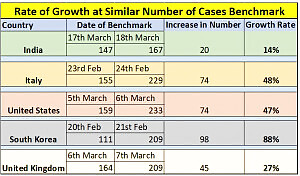
views
The fight against Coronavirus has gripped the entire world. The strategy for fighting this virus that first originated in China has varied from country to country. A pandemic at this scale is something that no country could have prepared for and that is why many nations have been found wanting in their response. This is the reason that protocols for first containing the spread and then dealing with the actual cases has evolved on a continuous basis.
The Indian Council of Medical Research (ICMR) released on March 19 the results of 826 random trials for suspected Covid-19 virus on people suffering from acute respiratory illness. All the tests turned negative. Thus, this test rules out any evidence of community spread so far. However, community spread may still take place later and so extreme caution would need to be maintained and the ICMR would continue to randomly tests for evidence of community spread.
Various countries have adopted different models to contain the virus. Testing, testing and more testing seems to be one method, as evidenced in South Korea. Social distancing is another method as practised in many countries, which initially ignored the warning signs but later scrambled to contain the spread. China itself, the source of the virus, and source of misinformation as well in early days, practised its own version of draconian measures.
What did India do? As has been recounted by various users on social media from first-hand experience, the government's response has been very proactive and ahead of the curve — and it started from aggressive screening of inbound passengers, the first carriers of the virus. The Ministry of Health issued its first notification of screening of all passengers coming from China on January 17 itself.
This aggressive protocol was then continuously reviewed and new measures added almost every few days — from cancelling of e-visas to placing of thermal scanners at all airports and seaports, to cancelling all existing visas (except diplomatic and official), to cancelling visa-free OCI card travel to completely restricting entry of anyone from EU and UK to closing all land borders with our neighbors to mandating 14-days mandatory quarantine for travellers arriving from specific countries which have shown high number of cases. These measures of screening at port of arrivals have been followed by aggressive protocol of contact tracing and follow-up or quarantine of all those who may have come in contact with those suspected of infection or of foreign travel.
Evidence so far shows this aggressive screening procedure has so far restricted the virus in Indian to stage 2 (foreign travel history and contacts with them) of local spread. Aggressive measures taken by state governments for social distancing — shutting down public spaces, work-from-home for private employees, shutting down schools, malls, cinema halls, pubs, gymnasiums, etc has also worked in containing the spread.

Let us look at another data set. Figure 1 above compares the rate of growth of confirmed cases at similar — number-of-cases benchmark. At 100+ cases benchmark (different countries reached this benchmark at different times), the growth rate of new confirmed cases in India is significantly lower than that of other countries which are similar to us — open societies, democracies and with robust press and free flow of information. China, for obvious reasons, has not been considered for this comparison.

Figure 2 above plots the growth factor, date wise. Growth factor is new cases added on a day compared to new cases the previous day. A growth factor significantly higher than one means the virus is spreading exponentially while the factor hovering around one or below obviously indicates the reverse. Between March 4 and 18, the growth factor has largely hovered around one, with rare exceptions.
Both the above graphs again lend credence to the ICMR confirmation that so far there is no evidence of community spread.
Some have suggested that the relatively low number of cases could be a result of deliberate under-reporting. This is highly unlikely. Patients reaching out to doctors, their contact tracing, their testing, data collection and all such efforts are being led at the district level by different state governments. It would stretch credulity to argue that the entire machinery of local administration to state government like that of Kerala, Maharashtra, Punjab, West Bengal and likes have come together in a grand conspiracy with the central government to under-report data.
If somehow, we still believe this theory and community spread has occurred, large number of patients would be reporting with symptoms in hospitals. Would a country like India, with free flow of information and a mobile camera in every hand and social media access, be able to hide such an eventuality? If actual cases were that much higher, would we not see evidence of that in our hospitals?
Essentially then, this is what seems to have happened.
As opposed to some countries that adopted the testing-testing-testing protocol, India seems to have adopted the screening-quarantining-preventing-social distancing protocol. This has so far has limited the spread of the virus to local level.
However, this is no reason to declare success as yet. In fact, far from it. The government need to be extremely vigilant, and keep ahead of the curve as it seems to have done so far. This would mean continuously evolving protocols, reacting in real time and taking all means necessary to prevent community spread. This would also mean cooperation of people in following the protocol established of quarantine and not behave irresponsibly. Many states have already banned large gatherings and imposed restrictive orders. These would need to be strictly adhered to, without leeway to any special interest group.
The results of central government under PM Modi, different state governments and cooperative behaviour of people can help India turn the corner. Let's be vigilant. Let's wait and watch.
(The author is CEO of BlueKraft Digital Foundation and former director of MyGov. Views are personal.)













Comments
0 comment